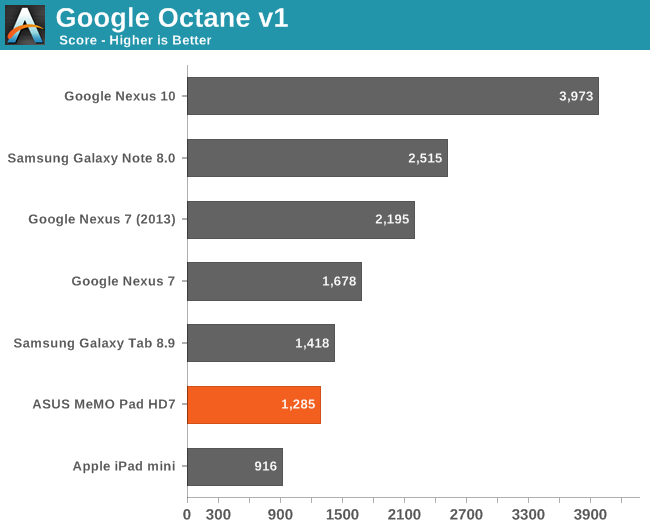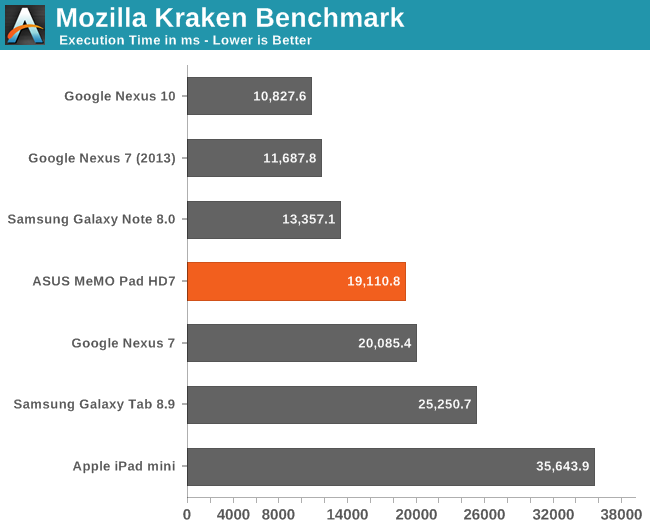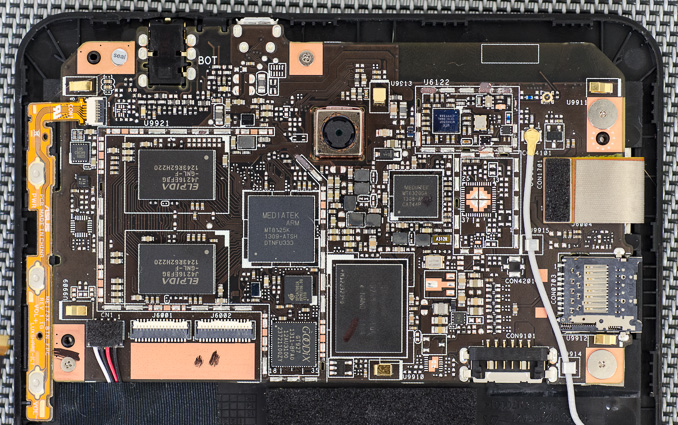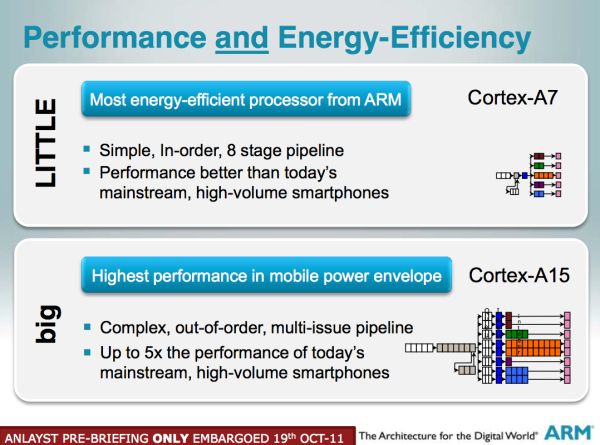ASUS MeMO Pad HD7 Review: $149 Nexus 7.1 Successor & Our First Look at MediaTek's MT8125
by Anand Lal Shimpi on July 29, 2013 3:55 PM EST- Posted in
- Tablets
- Asus
- Mobile
- Android 4.2
- MeMO Pad
MediaTek MT8125 Inside
To hit its $129/$149 price point, ASUS outfitted the MeMO Pad HD7 with a quad-core Cortex A7 based SoC from MediaTek: the MT8125. Before we get to the specifics of this SoC, it's important to put MediaTek in perspective since this is the first time we've ever reviewed one of its SoCs.
In our SoC coverage at AnandTech we tend to focus on the big five: Apple, Intel, NVIDIA, Qualcomm and Samsung. TI dropped out of the AP (Application Processor) space, and ST-E's future as a company is a bit uncertain. The benefit of ARM's business model however is that anyone can put its cores and/or ISA to use. You just need to have enough funding to pay for an ARM license and build an implementation team to get your SoC off the ground. While we're used to low cost markets being addressed by de-featured versions of high-end chips, in the ARM ecosystem there's another solution: the rise of the high-volume, low cost SoC vendor.
MediaTek, a Taiwan based fabless semiconductor manufacturer, is one of a number of ARM licensees that are presently giving Qualcomm (and other mobile SoC vendors) a hard time. They tend to take vanilla ARM (and 3rd party) IP, integrate it, and sell it for much less than the ARM licensees we're used to covering. Just as ARM's licensees are putting incredible pressure on Intel's margins in client computing, MediaTek is doing the same to the bigger ARM licensees.
Last year MediaTek shipped just under 1.7 billion chips. Granted that's across all markets that it serves (including APs, WiFi, GPS, DVD/BD player chipsets, etc…), but it's still tremendous volume.
If you look at any of the sub-$150 Android tablets these days, they all integrate some form of ultra low cost silicon. In large, cost-sensitive markets (e.g. China), MediaTek's presence is extremely high.
The MT8125 integrates four relatively early revision ARM Cortex A7 cores (r0p2). Each core can run at between 500MHz and 1.2GHz, and each core can be hot-plugged independently. I ran a bunch of low level memory tests and it looks like MediaTek opted for a fairly sensible 32KB/32KB L1 cache configuration (I$/D$). The L2 cache appears to be 1MB in size, shared between all four cores. NEON is supported.
Of the four cores, I noticed the first two are frequently active, with clock speeds usually up at 1.2GHz whenever you're doing anything (loading apps, scrolling, etc…). The third core usually plugs in to keep responsiveness up while doing anything more CPU intensive. The fourth core seems to occasionally get plugged during normal, non-heavily threaded use, but even then for very short periods of time.
We've only briefly discussed ARM's Cortex A7 here, so I'll offer some more details on the architecture since it's relevant. The Cortex A7 is ARM's Cortex A5 successor. It's a light-weight 32-bit core that is fully ISA compatible with the Cortex A15 (which is why we see it used in big.LITTLE configurations with the A15). The A7 is a fully in-order micro-architecture, unlike the OoO Cortex A9 (at least with respect to integer instructions). The A7's integer pipe is 8 stages deep, and has limited dual-issue capabilities (e.g. FP/NEON can't be dual-issued, branches can only be issued from one port, etc…). The execution back end is quite similar to the Cortex A8.
ARM's goal with the Cortex A7 was to deliver similar performance to the Cortex A8, but in a smaller area and at lower power. ARM claims a single Cortex A7 core could be fit into a 0.5mm^2 area on a modern 28nm process. That's roughly 1/6 the area required to implement a single AMD Jaguar core.
Feeding the quad-core Cortex A7 cluster is a single-channel (32-bit wide) DDR3L memory interface. ASUS opted for two 16-bit DDR3L-1066 devices on-board. My review sample used Elpida DDR3L, the same type found in iFixit's teardown of the new Nexus 7.
Performance in our standard suite of web based tests has the quad-core Cortex A7 MT8125 trading blows with the quad-core Cortex A9 Tegra 3 in the Nexus 7. When the two are similar, they tend to be pretty close, but when there's a lopsided victory it's usually well in favor of the Tegra 3/Nexus 7. That tends to mirror my experience with the MeMO Pad HD7. In many cases it feels close to the 2012 Nexus 7's performance, but there's an element of snappiness that's just not present. Some Android animations are a little choppier (e.g. bringing up the apps grid) compared to the Nexus 7. I do wonder how good MediaTek's memory controller implementation is. Remember that ARM only has to provide the CPU IP, the rest of the SoC is up to the designer to build/source.















75 Comments
View All Comments
skeighter - Tuesday, August 20, 2013 - link
these are great little tablets. bought one for my wife. she was constantly playing with her phone to access facebook, twitter, instagram, etc. All on a tiny screen. Bought her a nice Lenovo 10" tablet, but she never used it. This is just the right size. Very fast, runs circles around both of my two year old dual core tablets. Liked it so much I bought another for myself.MarkWebb - Tuesday, September 17, 2013 - link
Just got one, very zippy (surprised), 3 issues: it downloaded, installed and rebooted with 4.2.2 but About still shows 4.2.1 and I tried checking for updates but it now says I am up to date even though About is not reporting it; it seems to occasionally register a single tap as a double; and Kindle dims the brightness! By about 20%. Got this for the micro SD slot.Asus Memo Pad HD7 - Monday, October 7, 2013 - link
All the detectives know the power of Asus Memo Pad HD7?1. ♥ Miracast
2. ♥ Time-Lapse
3. ♥ Smart Cover
4. ♥ more later ...
Like us to get the cool update for your Memo Pad HD7
fb/memopadhd7 ♥
mfox - Thursday, November 14, 2013 - link
I have only had it for a few days, and have not had much time to really run it through its paces yet, but I am most likely going to return it. The display, especially. in regard to video, does seem really good. I have not found the device to be generally laggy so far, although I haven't really used it with many apps, under significant "load." My real complaint is with what I saw in some other reviews and was concerned about, the build, fit and finish and overall quality. it does seem creaky, the screen does seem like it is made from plastic, and the one I got had a little glue in the seam between the screen and the rest of the body. That seem seems to be of uneven width around the device and most likely will get other gunk caught in it. I really haven't had a chance to see if it has problems or works well with various apps, but will probably return it. I have ordered, believe it or not, a Dell venue 7, which has 1gb more internal memory, a decent (from what I have read) processor, and an equivalent screen. It runs stock android and is right now at 4.2 (like the asus), rather than 4.3, I think. And it is at a similar price point.danbc - Saturday, February 1, 2014 - link
Indeed, the presence of SDHC slot is a good option.Even on Nexus 7, you can use a stick over otg cable, it's not the same thing, because, on his Asus tablet, and all devices with sd slot, with proper software, like directory bind, you can efectively extend your sotrage space on the SD card .
I have a question for the writter: what is the name of the cpu usage monitor you used?